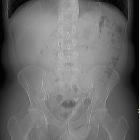Urethrakonkrement

Urethral
calculi presenting with acute urinary retention. Radiodense opacity at the penis level.

Urethral
calculus • Penile urethral calculus - Ganzer Fall bei Radiopaedia

Urethral
calculus • Urethral stone - Ganzer Fall bei Radiopaedia

Urethral
calculus • Urethral stone - Ganzer Fall bei Radiopaedia

Urethral
calculus • Urethral calculus - Ganzer Fall bei Radiopaedia

Urethral
calculus • Urethral calculus - Ganzer Fall bei Radiopaedia

Urethral
calculus • Urethral calculus - Ganzer Fall bei Radiopaedia

Urethral
calculus • Penile urethral calculus - Ganzer Fall bei Radiopaedia

Urethral
calculus • Impacted calculus in prostatic urethra - Ganzer Fall bei Radiopaedia

Urethral
calculus • Urethral calculus - Ganzer Fall bei Radiopaedia

Urethral
calculi presenting with acute urinary retention. Axial reconstruction at the penis base level shows two impacted urethral calculi (yellow arrow).

Urethral
calculus • Urethral calculus - Ganzer Fall bei Radiopaedia

Giant
urethral calculus in anterior urethral diverticulum: a case report. Irregular clumps was observed in the subcutaneous posterior scrotum in the prostate MR scan before lithotripsy

Giant
urethral calculus in anterior urethral diverticulum: a case report. A giant urethral calculus with a size of 6.5 × 6 × 5.5 cm was observed below the pubic symphysis in the enhanced urinary CT


Female
urethral diverticulum with calculus. MCUG showing urethral diverticulum with calculus.

Female
urethral diverticulum with calculus. Calculus opacity overlying pubic symphysis.

Urethral
calculi presenting with acute urinary retention. Sagittal reconstruction shows two impacted urethral calculi (yellow arrow) and another one of smaller dimension in the bladder lumen (white arrow). Note the Foley catheter adequately placed (green star).

2-teiliges,
großes Konkrement im Verlauf der Urethra als Zufallsbefund bei einer CT-Untersuchung wegen einer abdominellen Raumforderung. Der Befund ist so groß, dass das Konkrement mutmaßlich in einem Divertikel der Urethra liegt, klinisch waren keine Miktionsbeschwerden auffällig.
Urethral calculi are an uncommon type of urolithiasis, accounting for ~1% of all urinary tract stones.
Epidemiology
They almost all occur in males with two peak incidences - one in childhood and the other at 40 years .
Clinical presentation
Most commonly acute lower urinary tract symptoms and/or urinary retention.
Pathology
Urethral calculi are most commonly calcium oxalate (~85%) and can be either :
- primary: arising de novo secondary to other pathologies such as diverticuli, strictures, neurogenic bladder or foreign bodies
- secondary: originate in the upper urinary tract (much more common)
Location
Most impact in the prostatic urethra although ~40% (range 30-50%) are found in the anterior urethra .
Radiographic features
Almost all (98-100%) of urethral stones are reported to be radiopaque but most are small and only faintly radiopaque and up to 60% will be missed .
Differential diagnosis
- pelvic phlebolith
- prostatic calcification: transrectal ultrasound can be helpful for differentiation
- Coaptite injection
Siehe auch:
und weiter:

 Assoziationen und Differentialdiagnosen zu Urethrakonkrement:
Assoziationen und Differentialdiagnosen zu Urethrakonkrement:
